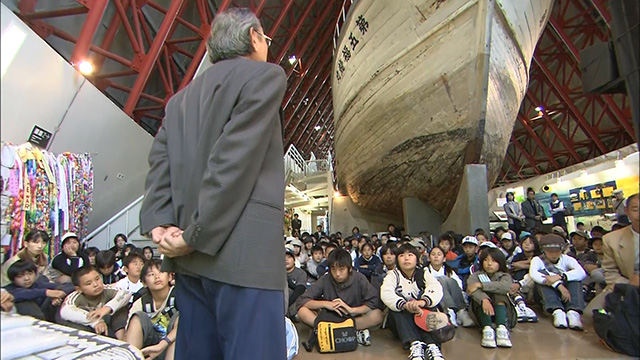The story of a boat
The Daigo Fukuryu Maru Exhibition Hall lies on a reclaimed plot of land near Tokyo Bay. The museum takes its name from a fishing boat, the Fukuryu Maru No. 5, that was at the heart of a tragic incident 65 years ago.
On March 1st, 1954, the US held its second hydrogen bomb test in the Pacific Ocean, near the Marshall Islands.
The Fukuryu Maru No.5 was 160 kilometers from the hypocenter, catching tuna. The crew didn't know about the test. The nuclear yield was one thousand times greater than that of the atomic bomb dropped on Hiroshima.
All 23 crewmembers were exposed to radiation. One died six months later, and the rest suffered from the effects for the rest of their lives.

The ship was decommissioned in 1967 and abandoned by the sea. Anti-nuclear activists campaigned for the boat to be preserved as a symbol of their cause. In 1976, the Tokyo Metropolitan Government built a facility to house the vessel near it was abandoned.
Kazuya Yasuda, the chief curator of the museum, gives tours to students and citizens.

These days, the museum is getting more foreign visitors, as it has been featured in some popular guidebooks.
"I think people in the United States have no awareness of this history at all," said one visitor. "We will take this back and share it with many people."
However, the overall visitor numbers are declining. At its peak in the early 1990s, the museum attracted over 300,000 guests a year. The figure is now down to around 100,000.
"65 years is a long time to have passed," Yasuda says. "We need to do something to get people involved. We can't just sit and wait for guests."
The fate of a crewmember

Matashichi Oishi is one of four living crewmembers. He was 20 at the time of the incident. He's 85 now and has suffered through various illnesses, including liver cancer and a lung tumor. He had a brain hemorrhage seven years ago, which left half his body paralyzed.

Oishi's life after the incident was a struggle. When he and the other crewmembers returned home after being hospitalized for a year and half, they were shunned and criticized for "causing trouble." They were also avoided in public because people believed radiation sickness was contagious.
"We prayed that everyone would just forget about the boat and our names," Oishi said in a 1989 interview. "We didn't want people to know we were involved in the incident."
Eventually, Oishi left home to escape the prejudice. He started a laundry business in Tokyo and hoped to never revisit the past.
But then one day, he was contacted by a group of junior high school students who wanted to hear his story for a school project.
Oishi was moved by the students' seriousness. He started talking about what had happened, for the first time in three decades.
''I saw the light running across the sky, turning everything yellow—the sky, the sea, and the boat.''
He has continued to tell his story ever since.

These days, his partial paralysis makes it difficult for him to talk. But he is nonetheless determined to keep sharing his experience, in the hope that something similar never happens again.
He's committed to keeping alive the memory of something that for years he had wished would simply be forgotten.
"Now what I dread most is that people will forget," Oishi said in a recent interview. " I'll keep telling my story so this doesn't happen."
For the future

One of the most popular features of the revamped museum is a video message from Oishi, talking about his experience and his hopes for the future.
For Yasuda, the chief curator, this is the reason the museum exists.
"Nuclear issues are not only a concern for Japan, but for the whole world," he says. "This museum should serve as a place for people to learn about what's happening around the world and reflect upon it."
The Daigo Fukuryu Maru Exhibition Hall says it expects more overseas visitors in the run-up to and during the 2020 Tokyo Olympics and Paralympics. Explanations are available in four languages--Japanese, English, Chinese, and Korean--and admission is free.

